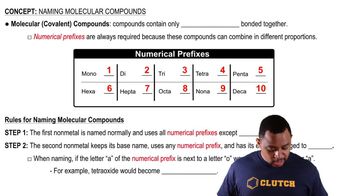Here are the essential concepts you must grasp in order to answer the question correctly.
Ionic Compounds
Ionic compounds are formed when atoms transfer electrons, resulting in the formation of charged ions. These compounds typically consist of a metal and a non-metal, where the metal loses electrons to become a positively charged cation, and the non-metal gains electrons to become a negatively charged anion. Ionic compounds are characterized by high melting and boiling points and conduct electricity when dissolved in water.
Recommended video:
Molecular Compounds
Molecular compounds are formed when two or more non-metal atoms share electrons through covalent bonds. These compounds are characterized by lower melting and boiling points compared to ionic compounds and do not conduct electricity in solution. The properties of molecular compounds depend on the types of atoms involved and the arrangement of the molecules.
Recommended video:
Naming Molecular Compounds
Chemical Formula Interpretation
The chemical formula of a compound provides essential information about its composition and structure. For example, CoCO₃ indicates the presence of cobalt (Co) and carbonate (CO₃) ions. Understanding the formula helps in determining whether the compound is ionic or molecular, as it reveals the types of elements involved and their bonding characteristics.
Recommended video:
Intepreting the Band of Stability
 Verified step by step guidance
Verified step by step guidance


